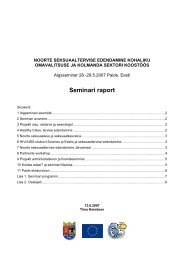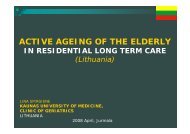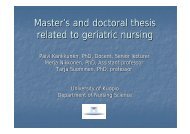EUR/RC62/wd08 (Eng) - WHO/Europe - World Health Organization
EUR/RC62/wd08 (Eng) - WHO/Europe - World Health Organization
EUR/RC62/wd08 (Eng) - WHO/Europe - World Health Organization
Create successful ePaper yourself
Turn your PDF publications into a flip-book with our unique Google optimized e-Paper software.
<strong>EUR</strong>/<strong>RC62</strong>/8<br />
page 22<br />
The evidence base<br />
103. The <strong>WHO</strong> Regional Office for <strong>Europe</strong> has promoted collaborative work aimed at<br />
presenting the economic case for public health action, particularly preventing chronic<br />
noncommunicable diseases. This work moves beyond what is known about the economic<br />
benefits of specific actions within health care systems, such as vaccinations and screening, to<br />
examine research endeavours to make the economic case for investing upstream – that is, before<br />
the onset of noncommunicable diseases and before health care services are required. The work<br />
highlights priority actions supported by sound cost–effectiveness or cost–benefit analyses,<br />
including actions to limit risky behaviour such as tobacco use and alcohol consumption, to<br />
promote physical and mental health through diet and exercise, to prevent mental disorders and<br />
to decrease preventable injuries, such as from road crashes, and exposure to environmental<br />
hazards. The full results of this work are forthcoming (36), but some of the early evidence is<br />
presented below.<br />
104. Strong evidence indicates the cost–effectiveness of tobacco control programmes, many of<br />
which are inexpensive to implement and have cost-saving effects. Such programmes include<br />
raising taxes in a coordinated way with a high minimum tax (the single most cost-effective<br />
action), encouraging smoke-free environments, banning advertising and promotion, and<br />
deploying media campaigns. Adequate implementation and monitoring, government policies<br />
independent of the tobacco industry and action against corruption are all needed to support<br />
effective policies.<br />
105. A substantive evidence base of systematic reviews and meta-analyses supports the cost–<br />
effectiveness of alcohol policies. Impressive cost-effective interventions include restricting<br />
access to retailed alcohol; enforcing bans on alcohol advertising, including in social media;<br />
raising taxes on alcohol; and instituting a minimum price per gram of alcohol. Less, but still<br />
cost-effective measures include enforcing drink–driving laws through breath-testing; delivering<br />
brief advice for higher-risk drinking; and providing treatment for alcohol-related disorders.<br />
106. Actions to promote healthy eating are especially cost-effective when carried out at the<br />
population level. Reformulating processed food to decrease salt, trans-fatty acids and saturated<br />
fat is a low-cost intervention that may be pursued through multistakeholder agreements, which<br />
may be voluntary or ultimately enforced through regulation. Fiscal measures (including taxes<br />
and subsidies) and regulating food advertising for children also have a low cost and a favourable<br />
cost–effectiveness. However, conflicting interests could hinder feasibility. Programmes to<br />
increase awareness and information, such as mass-media campaigns and food labelling<br />
schemes, are efficient investments but have poorer effectiveness, particularly in lower<br />
socioeconomic groups.<br />
107. Promoting physical activity through mass-media campaigns is a very cost-effective action<br />
and relatively inexpensive. However, returns in terms of health outcomes may be lower than<br />
those provided by more targeted interventions, for instance at the workplace. Changes in the<br />
transport system and the wider environment have the potential to increase physical activity, but<br />
they require careful evaluation to ascertain their affordability and feasibility, and whether the<br />
changes reach those with greater health and social needs. Actions targeting the adult population<br />
and individuals at higher risk tend to produce larger effects in a shorter time frame.<br />
108. Robust evidence indicates that preventing depression, the single leading cause of<br />
disability worldwide, is feasible and cost-effective. Depression is associated with premature<br />
death and reduced family functioning, it directly affects people’s individual behaviour and it<br />
entails extremely high economic costs due to health care and productivity losses, which can be<br />
partly avoided through appropriate forms of prevention and early detection. Evidence supports<br />
actions across the life-course, starting with early action in childhood to strengthen social and









